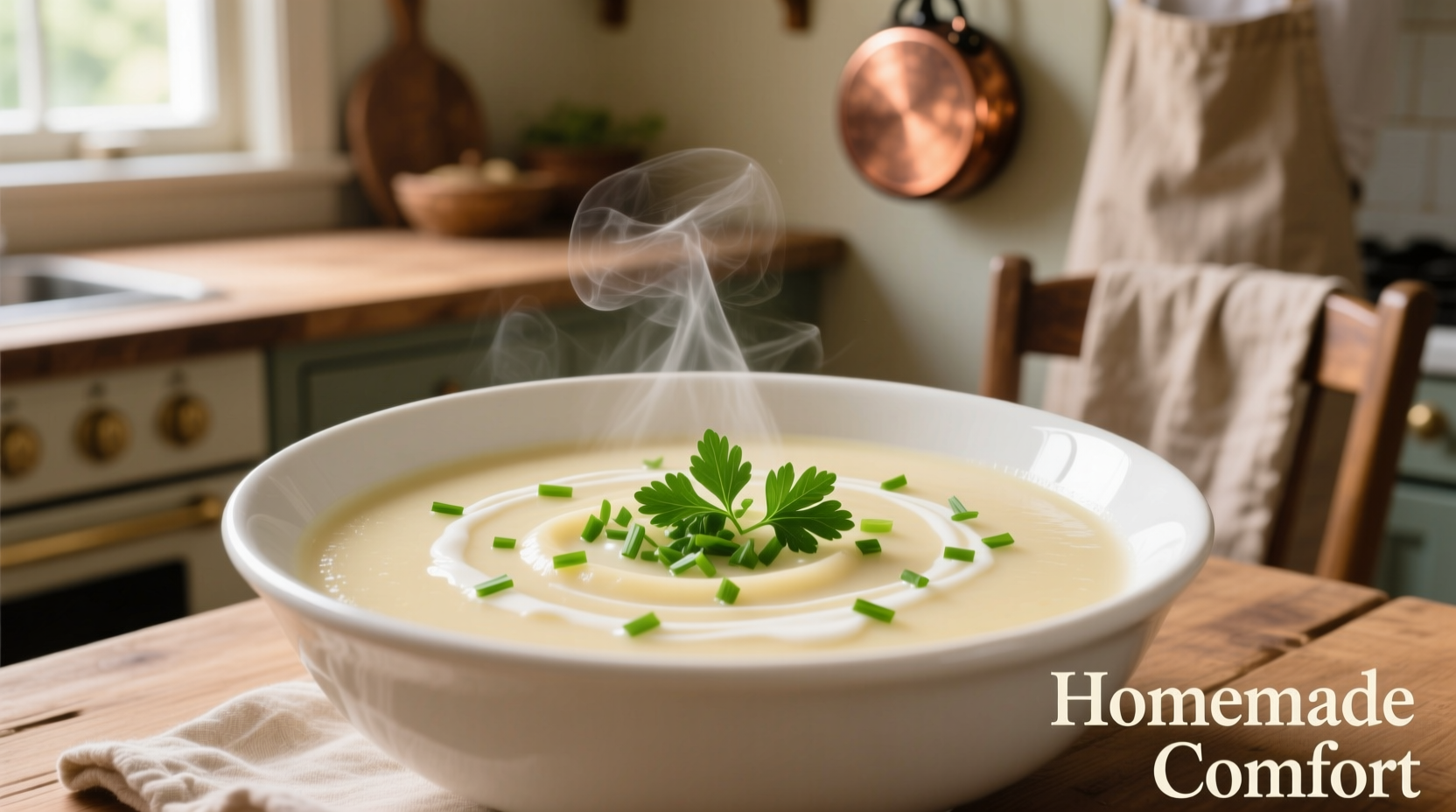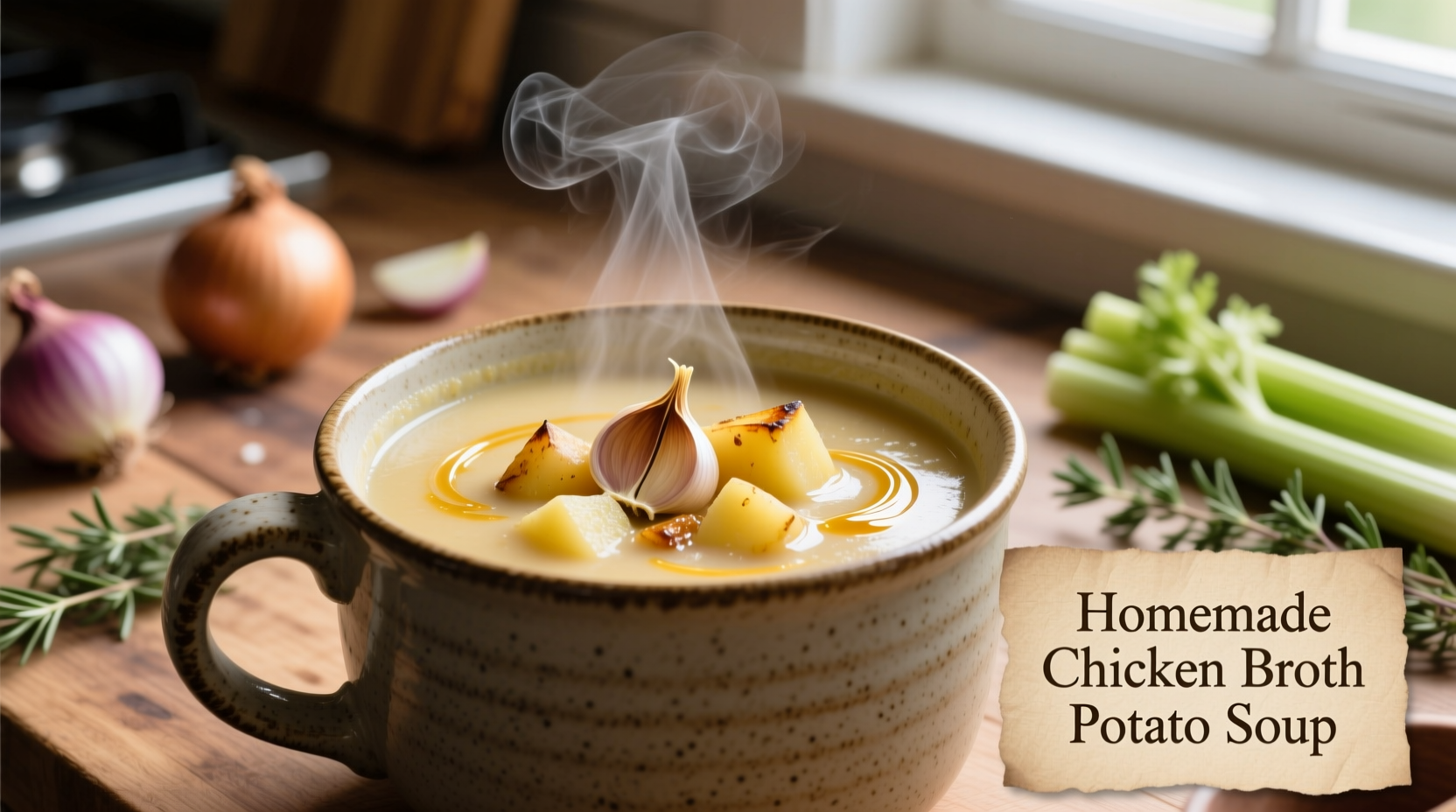There's nothing quite as comforting as a bowl of creamy potato soup on a chilly day. While many recipes call for heavy cream or milk, using quality chicken broth as your base creates a lighter yet deeply flavorful soup that satisfies without weighing you down. As a chef who's perfected this recipe through years of testing in both professional kitchens and home settings, I've discovered the precise techniques that transform simple ingredients into something extraordinary.
Why Chicken Broth Makes the Best Potato Soup Base
Chicken broth provides a savory depth that water simply can't match, while keeping the soup lighter than dairy-based versions. The natural gelatin in good quality broth creates a luxurious mouthfeel without needing heavy cream. When selecting broth, look for low-sodium varieties to control the salt level in your final dish.
| Broth Type | Flavor Profile | Best For | Sodium Content |
|---|---|---|---|
| Homemade chicken broth | Rich, complex, nuanced | Special occasions, best flavor | Low (adjustable) |
| Low-sodium store-bought | Consistent, reliable | Everyday cooking | 200-300mg per cup |
| Regular store-bought | Salt-forward, less nuanced | When reducing liquid | 700-900mg per cup |
| Vegetable broth | Lighter, earthier | Vegetarian adaptation | Varies widely |
This comparison from the USDA FoodData Central shows why low-sodium chicken broth gives you the most control over your final dish's flavor profile. Professional chefs consistently prefer starting with low-sodium broth so they can adjust seasoning precisely during cooking.
Essential Ingredients and Smart Substitutions
The beauty of potato soup lies in its simplicity, but each ingredient plays a crucial role:
- Potatoes - Russet or Yukon Gold work best. Russets create a fluffier texture while Yukon Golds add natural creaminess
- Chicken broth - Low-sodium preferred for flavor control
- Aromatics - Onion, garlic, and celery form the flavor foundation
- Thickener - A simple roux (butter and flour) creates perfect texture without dairy
- Seasonings - Fresh thyme, bay leaf, and a touch of smoked paprika elevate basic ingredients
For dietary adaptations:
- Gluten-free: Substitute cornstarch or arrowroot for the flour in your roux
- Dairy-free: The broth-based version is naturally dairy-free (skip any milk/cream additions)
- Lower carb: Replace half the potatoes with cauliflower florets
Step-by-Step Cooking Process
Prep Work: Setting Yourself Up for Success
Proper preparation prevents common potato soup pitfalls. Start by peeling and dicing potatoes into uniform 1/2-inch cubes—this ensures even cooking. Soak the diced potatoes in cold water for 10 minutes to remove excess starch, which prevents gummy texture. Chop your aromatics finely so they dissolve into the broth rather than creating chunky bits.
The Flavor Foundation: Building Layers of Taste
The secret to exceptional potato soup isn't just the ingredients—it's how you combine them:
- Sauté onions, celery, and garlic in butter until translucent (5-7 minutes)
- Add flour to create a roux, cooking for 2 minutes to eliminate raw flour taste
- Gradually whisk in chicken broth to prevent lumps
- Add potatoes, thyme, bay leaf, and a pinch of smoked paprika
- Simmer gently until potatoes are fork-tender (15-20 minutes)
Avoid boiling vigorously, which can break down potatoes too much. The ideal simmer maintains small bubbles breaking the surface occasionally.

Troubleshooting Common Issues
Even experienced cooks encounter these potato soup challenges:
- Too thin? Simmer uncovered for 5-10 minutes to reduce, or make a slurry of 1 tbsp cornstarch + 2 tbsp cold water
- Too thick? Add additional broth or water, 1/4 cup at a time
- Bland flavor? Add acid—try 1 tsp lemon juice or apple cider vinegar to brighten flavors
- Potatoes falling apart? You likely boiled too vigorously or used waxy potatoes
Serving and Storage Tips
For the best presentation, ladle soup into pre-warmed bowls. Garnish with fresh chives, a sprinkle of crispy bacon, or a drizzle of olive oil. Potato soup actually improves overnight as flavors meld—store in an airtight container in the refrigerator for up to 4 days.
When reheating, do so gently over medium-low heat to prevent separation. If the soup has thickened too much in storage, simply add a splash of broth while reheating. Freezing is possible but may slightly alter the potato texture—freeze for up to 3 months for best results.
How Potato Soup Has Evolved Through History
Potato soup has humble origins but has evolved significantly:
- 16th century: Potatoes introduced to Europe from South America; early soups were simple peasant fare
- 18th century: French chefs began incorporating dairy, creating richer versions
- 19th century: Immigrants brought regional variations to America, often using available broth bases
- 20th century: Canned versions became popular, though lacking depth of homemade
- Today: Focus on quality ingredients and technique has revived interest in from-scratch versions
This historical perspective from the Food and Agriculture Organization shows why modern cooks are returning to broth-based preparations that honor the soup's simple origins while maximizing flavor potential.
Frequently Asked Questions
Can I make potato soup without dairy using chicken broth?
Yes, chicken broth creates a naturally creamy texture without dairy. For extra richness, blend half the cooked potatoes before adding remaining ingredients. The natural starch in potatoes thickens the broth beautifully while keeping the soup dairy-free.
How do I prevent my potato soup from becoming gluey?
Soak diced potatoes in cold water for 10 minutes to remove excess starch, then drain well before adding to soup. Avoid over-blending if making creamy soup, and never boil vigorously—simmer gently instead. Using the right potato variety (Russet or Yukon Gold) also prevents gummy texture.
What's the best way to store and reheat potato soup?
Store in an airtight container in the refrigerator for up to 4 days. When reheating, do so gently over medium-low heat to prevent separation. If the soup has thickened too much, add a splash of broth while reheating. Potato soup actually improves overnight as flavors meld together.
Can I use vegetable broth instead of chicken broth?
Absolutely. Vegetable broth creates a delicious vegetarian version. For best results, use a mushroom-based vegetable broth which provides similar umami depth to chicken broth. You may want to add 1/2 tsp nutritional yeast to boost savory notes in the vegetarian version.
How can I add more protein to chicken broth potato soup?
Add shredded cooked chicken during the last 5 minutes of cooking. For vegetarian protein, stir in 1/2 cup white beans or lentils with the broth. Diced ham or bacon added during the sauté step also boosts protein content while enhancing flavor.











 浙公网安备
33010002000092号
浙公网安备
33010002000092号 浙B2-20120091-4
浙B2-20120091-4